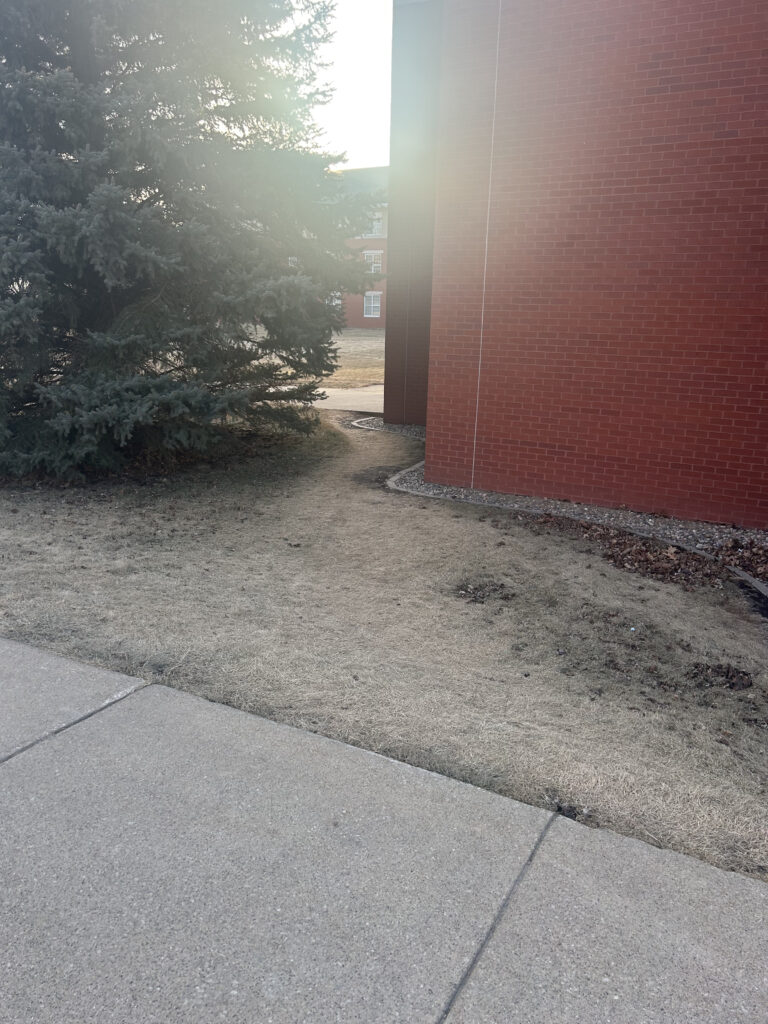As you walk across campus it is easy to see plenty of paths. Cement creates sidewalks that connect buildings, and many of the sidewalks can lead anywhere on campus as long as you continue along and take the right turns. However, if you pay attention, other paths are found on campus in the form of matted grass, broken bushes and perhaps even footprints. These unpaved foot treaded paths are known as desire paths.
A desire path is typically described as “an unplanned route or path, such as one worn into a grassy surface by repeated foot traffic, that is used by pedestrians in preference to or in the absence of a designated alternative, such as a paved pathway.” Often times these makeshift paths are produced due to people choosing the most direct path from one spot to another.
A perfect example of a desire path on campus can be found on the green in between the Dewitt Performing Arts center and Van Persum Hall (VPH). Hospers Hall, one of the main users of this path has dubbed this walkway “Hospers Highway.” If you look closely at the “Highway” you can see a clear line of matted yellowed grass that sticks out when compared to the grass in the rest of the green. The men of Hospers use this path primarily to get to the caf for meals, but also to get to any buildings on the southwest side of campus.
“The Highway saves time. No one wants to walk either side of the triangle, they want to take the hypotenuse.” Hospers Resident Assistant Jaden Lorang sai. “Lots of people are worried about efficiency or time, which is a big reason it gets used so much.”
Hospers Highway is not the only place you can find desire paths. Students who frequent the Dewitt Family Science Center may have notice the patch of shrubbery missing when entering into the northeast door of the building. Whereas grass covers a corner to the north of the door, there is a clear chunk missing where you can see many people cut through in order to shorten their walking distance.
Another desire path can be found in between Ramaker and the science building as students commute from Christ Chapel to the RSC. Near the “yoga mats” and the surrounding green area you can find matted grass a staple to any good desire path.
When looking into the reason behind desire paths, it seems that most people choose these paths to save time or reduce walking distance. “I don’t think there is anything wrong with people wanting to save a little bit of time.” Lorang said.
An interesting conversation brought up when talking about desire paths has to do with how paths and spaces are planned for. Why not just pave these desire paths? How is it that these paths have been made of trampled grass for so long instead of cement? When thinking of campus layout, it is hard to plan for what paths students may take. As new buildings are put up and old ones are torn down, it is hard to plan ahead for what paths should look like.
“You would not want there to be sidewalks for every single path.” Drew Fleury said. “If you map out where each path is and put cement in each spot eventually there is no green. You might as well put in a big parking lot.”
Planning for desire paths seems to be a problem faced at much larger scales as well. When it comes to urban planning, often times planners have to think ahead in order to ensure safety for residents. In just a few minutes of research it is easy to find numerous stories about how poor city planning can lead to increased desire paths, and how this only leads to more money being spent.
Desire paths can be found just about anywhere, whether it be jaywalking across a street, cutting through a green area or cutting through buildings. On campus, it is easy to see the matted grass and the masses of people that take these shortcuts. To many, these paths are a beloved or at least an appreciated part of their campus experience. So, next time you’re late to class, or perhaps contemplating quickest routes, just look to the ground and see where others have gone for years before you.

Photo submitted.